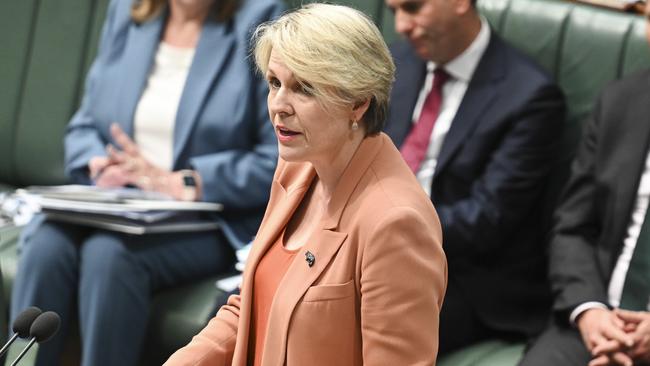Blue-Bended Bee Post Office mural among Tanya Plibersek’s reasons to veto Blayney gold mine
The Environment Minister cited a Bathurst Post Office mural to back up a Dreaming story that the Orange Land Council says should not be used to veto Regis Resource’s gold mine at Blayney.

Environment Minister Tanya Plibersek has cited a mural on a central NSW post office as proof of the existence of the blue-banded bee dreaming story, one of the central reasons she killed the Blayney goldmine proposal despite evidence from the local land council that the story is not Wiradjuri tradition.
The Environment Minister’s newly-released reasons for blocking the billion dollar project in its current form show she decided the renegade anti-mine Indigenous group had made several claims about the significance of the site that were unsubstantiated. However she sided with that group over the existence and significance of a highly-contested dreaming story about the blue-banded bee.
Ms Plibersek accepted the claim of the Wiradjuri Traditional Owner Central West Aboriginal Corporation that the dreaming story is part of Wiradjuri tradition. The small registered charity, known as WTOCWAC, claimed that historically the bee dreaming would have been taught as part of pre-initiation ceremonies.
Referring to a mural at the Bathurst post office, Ms Plibersek wrote: “Information about a public artwork by Wiradjuri artist Baranga Wiradjuri, named the Blue Banded Bee Creation Story, was also submitted to support the validity of the Dreaming as an Aboriginal tradition”.
“Whilst not identical, the description of the artist’s interpretation of the Dreaming is largely consistent with WTOCWAC’s explanation,” Ms Plibersek said.

The Orange land council has repeatedly claimed Ms Plibersek was taken in by baseless claims. The land council disputed the claims about blue banded bee dreaming in evidence to Ms Plibersek in February. Ms Plibersek acknowledged the Orange land council submissions by six of its representatives – five of whom identify as Wiradjuri – but rejected it.
“Regarding the (Orange land council) submissions disputing the existence of the Dreaming, I considered this to be consistent with WTOCWAC’s submission that the Dreaming is knowledge that is only passed to specific custodians in accordance with Aboriginal oral tradition,” she wrote.
“I was satisfied that, based on publicly available information and submissions made by WTOCWAC, the knowledge holder who passed down the knowledge of the Dreaming was a prominent Wiradjuri Elder who was recognised by the wider Bathurst community as such.

“I was satisfied that the passing down of the story was consistent with the way in which Aboriginal oral traditions and beliefs are often passed down throughout history.
“For these reasons, I found that the Dreaming is an Aboriginal tradition.”
Regis Resources had cleared every state and Commonwealth hurdle for its proposed goldmine in central NSW when in August Ms Plibersek declared a no go zone over the approved site for the mine’s tailings dam.
She did this after considering an application under Aboriginal heritage laws by elder Nyree Reynolds, an artist who moved to Blayney from the Blue Mountains about 40 years ago. Ms Reynolds had previously submitted her paintings of the Belubula River and surrounds to the NSW independent Planning Commission as evidence of its significance to Wiradjuri people.

The paintings were submitted with captions including “The Wiradjuri are being driven out … again”. She included an essay against mining that said in part: “The Ancestors who are leaving will turn around and come back should this land be saved from the ravages of mining”.
The planning commission subsequently ruled in May 2023 that the mine could go ahead.

Ms Plibersek’s last-minute intervention in the mine proposal prompted Regis to warn it would be five to 10 years before it could potentially find an alternative site. Her reasons, published Friday, explain on which points she agrees with Ms Reynolds and the group supporting her, the Bathurst-based Wiradjuri traditional owners Central West Aboriginal Corporation.

For example, Ms Plibersek rejected the Wiradjuri traditional owner corporation’s claim that the proposed minesite was of particular significance to Wiradjuri people because of culturally-modified trees that are sometimes called scar trees. The group had nominated a tree that was not on the site and “no detailed evidence was provided to explain how ancestral and culturally modified trees were connected to the specified area”.
She also did not support its claim that the area was of particular significance to the Three Brothers Dreaming story. She also rejected the Wiradjuri traditional owners corporation claim the area was of particular significance because of the presence of Aboriginal sites including Aboriginal camp ovens and stone tools “identified by supporting parties”.
The nature and significance of artefact “scatters” in the area have been repeatedly questioned by the Orange land council, which claims a “camp oven” was nothing more than cinders that a farmer claimed to have ploughed over decades ago.
“I was not satisfied that the artefact scatters and isolated finds were of particular significance to Aboriginal people in accordance with Aboriginal tradition,” Ms Plibersek writes in her reason.
Ms Plibersek also did not support a claim by the mine opponents that the area was of special significance to Wiradjuri people because of connections to Aboriginal peoples past, ruling “the information pertaining to this matter was general in nature and only demonstrated the historical occupation of the specified area and broader landscape”.






To join the conversation, please log in. Don't have an account? Register
Join the conversation, you are commenting as Logout